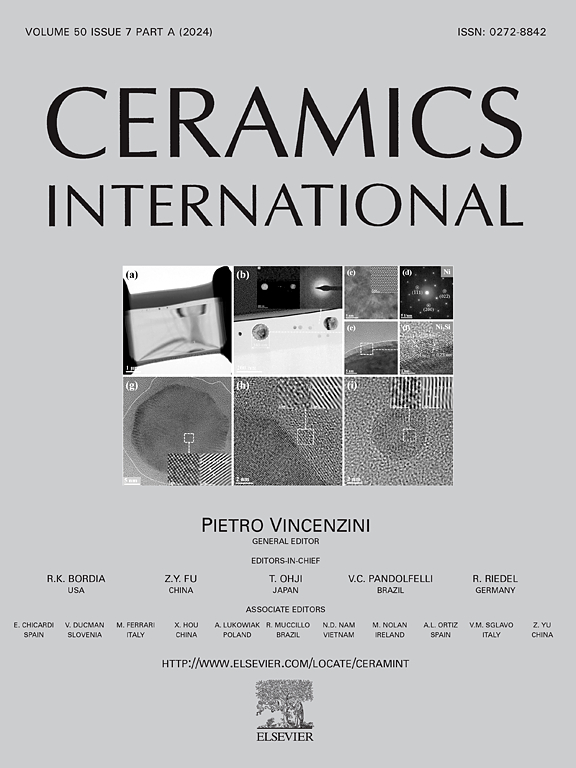La3+和Eu3+掺杂对铋铁氧体陶瓷结构、微观结构和铁电性能的影响
IF 5.6
2区 材料科学
Q1 MATERIALS SCIENCE, CERAMICS
引用次数: 0
摘要
本文研究了Bi1- xlaxfeo3 (x = 0.05, 0.10, 0.15), Bi1- yeuyfeo3 (y = 0.05, 0.10, 0.15)和Bi1-(x + y)LaxEuyFeO3 (x = y = 0,0.025, 0.05, 0.075)组成的陶瓷样品。样品通过水蒸发法合成,随后在835℃下进行烧结。重点研究了样品的结构和微观结构与铁电性能之间的关系。该研究还强调了La3+和Eu3+掺杂离子对材料性能的不同影响,有助于更深入地了解这些复杂陶瓷体系中影响铁电性的机制。XRD分析表明,镧和铕取代铋铁氧体陶瓷均以菱形(R3c)结构为主,而掺15mol %掺杂离子的样品也含有正交相。用10 mol%的La3+或Eu3+和15 mol%的La3+部分取代Bi3+离子可显著增强铁电反应。与未掺杂和其他掺杂样品相比,这些成分具有更大的残余极化,更高的矫顽力场和接近方形的磁滞曲线。在160 kV/cm的电场作用下,Bi0.85La0.15FeO3样品显示出最高的残余电极化(Pr = 24 μC/cm2)。由于其独特的结构和微观结构特性,该材料在高电场下表现出接近饱和的磁滞回线,并伴有最小的泄漏电流。Bi0.85Eu0.15FeO3和Bi0.85La0.075Eu0.075FeO3样品由于其组成中的非极性、正交结构而表现出较差的铁电响应。一般来说,镧和铕掺杂显著降低了铋铁氧体的漏电流密度,这是由于氧空位浓度的降低,而氧空位是导致未掺杂陶瓷电导率的主要原因。本文章由计算机程序翻译,如有差异,请以英文原文为准。
Effect of La3+ and Eu3+ doping on the structural, microstructural, and ferroelectric properties of bismuth ferrite ceramics
This work investigates a series of ten ceramic samples with the compositions Bi1-xLaxFeO3 (x = 0.05, 0.10, 0.15), Bi1-yEuyFeO3 (y = 0.05, 0.10, 0.15), and Bi1-(x + y)LaxEuyFeO3 (x = y = 0, 0.025, 0.05, 0.075). The samples were synthesized through a hydro-evaporation method and subsequently subjected to sintering at 835 °C. The focus was on the relationship between the samples' structural and microstructural properties and their ferroelectric behavior. The study also emphasized the distinct effects of the La3+ and Eu3+ dopant ions on the material properties, contributing to a deeper understanding of the mechanisms influencing ferroelectricity in these complex ceramic systems. XRD analysis revealed that all lanthanum and europium substituted bismuth ferrite ceramics had the rhombohedral (R3c) structure as the dominant one, while the samples doped with 15 mol% of dopant ions contained the orthorhombic phases as well. The partial substitution of Bi3+ ions with 10 mol% of La3+ or Eu3+ and 15 mol% of La3+ resulted in significantly enhanced ferroelectric responses. These compositions showed larger remnant polarizations, higher coercive fields, and nearly square-shaped hysteresis curves compared to the undoped and other doped samples. The Bi0.85La0.15FeO3 sample demonstrated the highest remnant electric polarization (Pr = 24 μC/cm2) when subjected to a 160 kV/cm electric field. Due to its unique structural and microstructural properties, the material exhibited nearly saturated hysteresis loops under high electric fields, accompanied by minimal leakage currents. The Bi0.85Eu0.15FeO3 and Bi0.85La0.075Eu0.075FeO3 samples exhibited poor ferroelectric responses due to non-polar, orthorhombic structures in their composition. Generally, La and Eu-doping significantly reduced the leakage current densities of bismuth ferrite owing to a decrease in the concentration of oxygen vacancies, which are known to be a primary cause of electric conductivity in undoped ceramics.
求助全文
通过发布文献求助,成功后即可免费获取论文全文。
去求助
来源期刊

Ceramics International
工程技术-材料科学:硅酸盐
CiteScore
9.40
自引率
15.40%
发文量
4558
审稿时长
25 days
期刊介绍:
Ceramics International covers the science of advanced ceramic materials. The journal encourages contributions that demonstrate how an understanding of the basic chemical and physical phenomena may direct materials design and stimulate ideas for new or improved processing techniques, in order to obtain materials with desired structural features and properties.
Ceramics International covers oxide and non-oxide ceramics, functional glasses, glass ceramics, amorphous inorganic non-metallic materials (and their combinations with metal and organic materials), in the form of particulates, dense or porous bodies, thin/thick films and laminated, graded and composite structures. Process related topics such as ceramic-ceramic joints or joining ceramics with dissimilar materials, as well as surface finishing and conditioning are also covered. Besides traditional processing techniques, manufacturing routes of interest include innovative procedures benefiting from externally applied stresses, electromagnetic fields and energetic beams, as well as top-down and self-assembly nanotechnology approaches. In addition, the journal welcomes submissions on bio-inspired and bio-enabled materials designs, experimentally validated multi scale modelling and simulation for materials design, and the use of the most advanced chemical and physical characterization techniques of structure, properties and behaviour.
Technologically relevant low-dimensional systems are a particular focus of Ceramics International. These include 0, 1 and 2-D nanomaterials (also covering CNTs, graphene and related materials, and diamond-like carbons), their nanocomposites, as well as nano-hybrids and hierarchical multifunctional nanostructures that might integrate molecular, biological and electronic components.
 求助内容:
求助内容: 应助结果提醒方式:
应助结果提醒方式:


